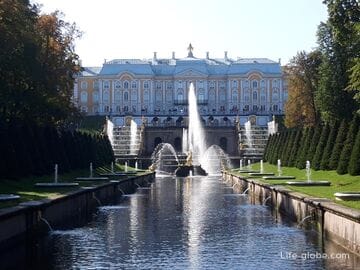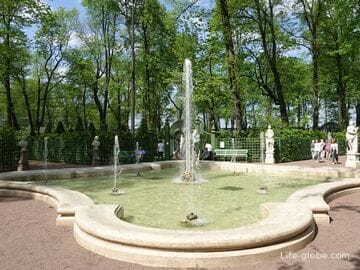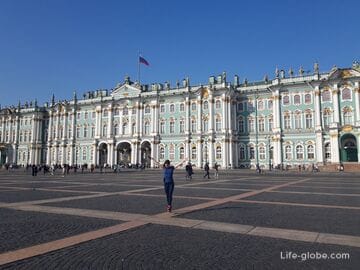Alexander Park - a large park adjacent to The Great Tsarskoye Selo (Catherine) Palace with the adjacent eponymous Catherine Park, on the side of the parade ground (the courtyard with the Golden Gate).
Alexander Park, together with Catherine Park, are an integral part of the former Tsarskoye Selo Imperial residence and are part of the State Museum-Reserve "Tsarskoye Selo".
The park is located in the city of Pushkin in St. Petersburg (the former Tsarskoye Selo).
Alexander Park has an area of about 200 hectares. and it is divided into a New Garden (a regular part of the park with a geometrically correct layout) and a Landscape Park.
The main entrance to the park is located opposite the Golden Gate of the Catherine Palace. The park can also be accessed through other entrances.
The main dominant feature of the park is the Alexander Palace.
In addition to the palace, there are pavilions on the territory of the Alexander Park, one of which now houses a museum, monuments and bridges erected in various architectural styles, as well as ponds, low hills, natural forest areas, alleys and paths for walking with places for recreation.
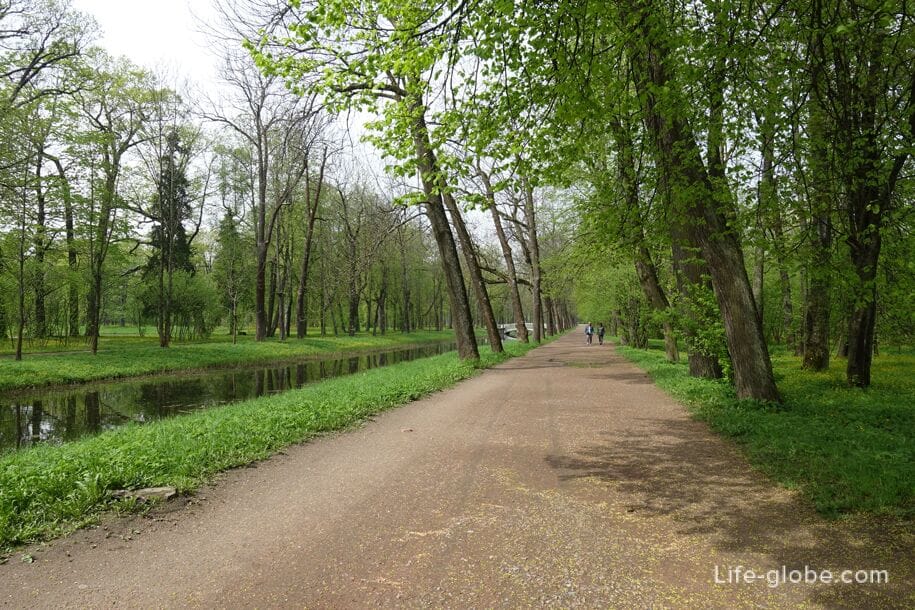
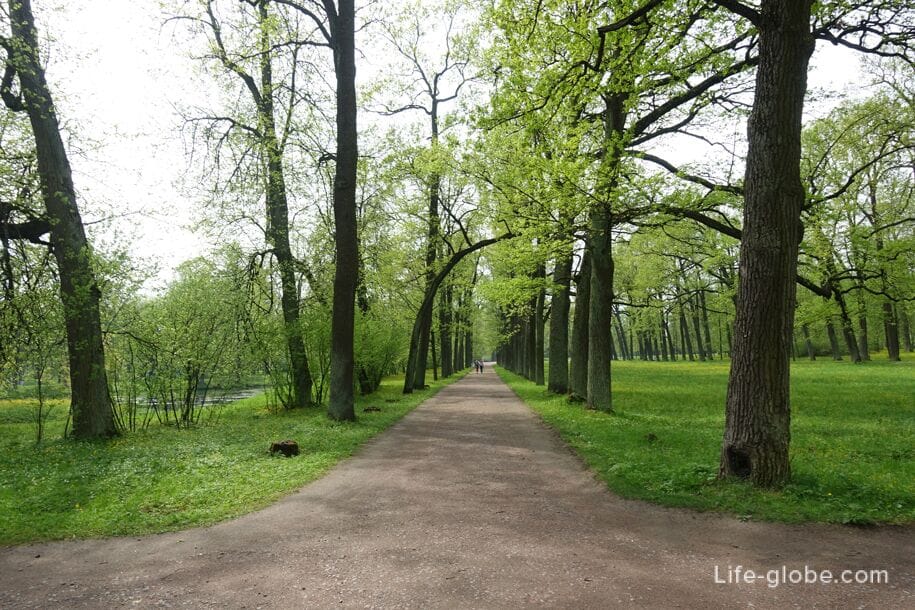

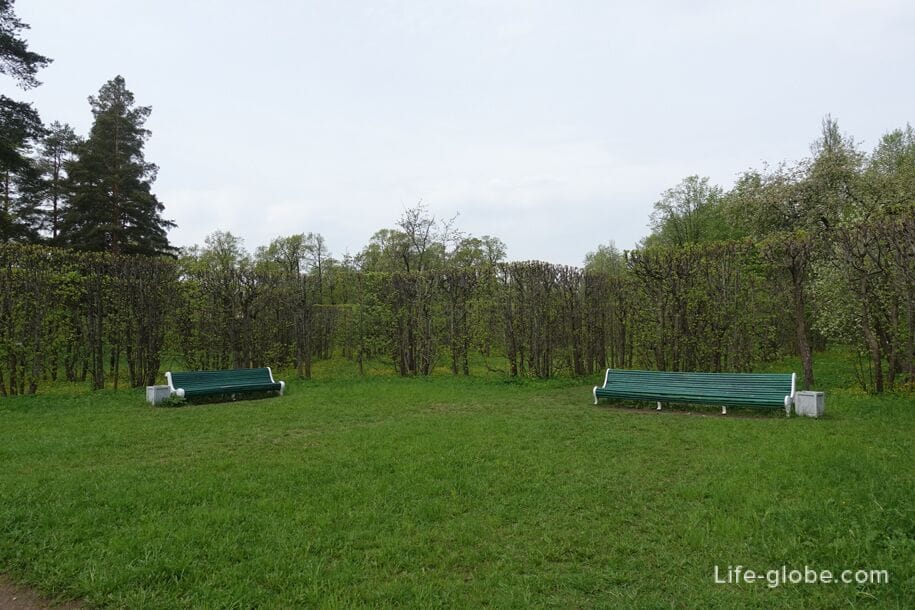


Alexander Palace
The Alexander Palace (the old name of the New Tsarskoye Selo Palace) is one of the imperial palaces of Tsarskoye Selo, built in the style of Palladian classicism in 1792-1796 by the Italian architect Giacomo Quarenghi.
The palace was built by order of Empress Catherine II as a gift for the wedding of her grandson, Grand Duke Alexander Pavlovich (the future Emperor Alexander I) with Grand Duchess Elizabeth Alekseevna.
The work on the construction of the palace was carried out under the supervision of the architect P.V. Neelov. Other famous architects participated in the subsequent decoration and reconstruction of the palace's interiors: L. Ruska, K. Maker, S. Cherfolio, A.A. Ton, V.P. Stasov, D.E. Efimov, A.I. Shtakenshneider, A.F. Vidov, S.A. Danini, R.F. Meltzer.
Alexander I preferred to stay in the Great Tsarskoye Selo Palace (the nearby Catherine Palace) during his stay in Tsarskoye Selo, but his successor Nicholas I loved the Alexander Palace and paid special attention to its improvement.
For the grandson of Nicholas I, Grand Duke Alexander Alexandrovich, the future Emperor Alexander III, the Alexander Palace was a grand ducal residence (his apartments were located in the left wing of the building), however, after becoming emperor, Alexander III preferred Gatchina from the summer palaces.
Since 1904, the Alexander Palace has become the permanent residence of Emperor Nicholas II, who was born in the palace and treated Tsarskoye Selo with special warmth. So, at the beginning of the 20th century, many important events related to Russian state life took place in the Alexander Palace: receptions of ambassadors and foreign figures, celebrations of anniversaries, etc.
After the revolution of 1917, in 1918 the Alexander Palace was opened to visitors as a state museum. Later, in the left wing there was a Rest House for NKVD employees, and on the second floor of the right wing, on the site of the closed rooms of the children of Nicholas II, there was an Orphanage named after Young Communards.
During the Great Patriotic War, during the occupation of the city of Pushkin, the Alexander Palace housed German and Spanish military units, and the square in front of the palace was turned into a Nazi cemetery.
At the end of the war, the palace was mothballed. After that, extensive restoration work was carried out in the palace, including some of the lost palace interiors.
The Alexander Palace is located in the northern part of the Alexander Park and is an elongated two-story building with double wings on the sides.
In the center, the main facade of the palace is decorated with two rows of monumental columns, which make up a through colonnade of the Corinthian order. On the opposite side (from the regular part of the Alexander Park), the facade of the palace is made in the form of a semi-rotunda covered with a spherical dome.
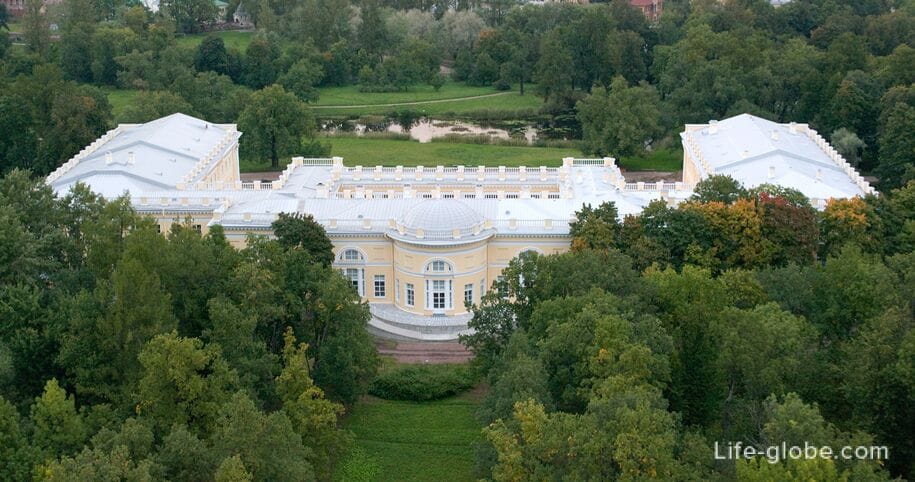
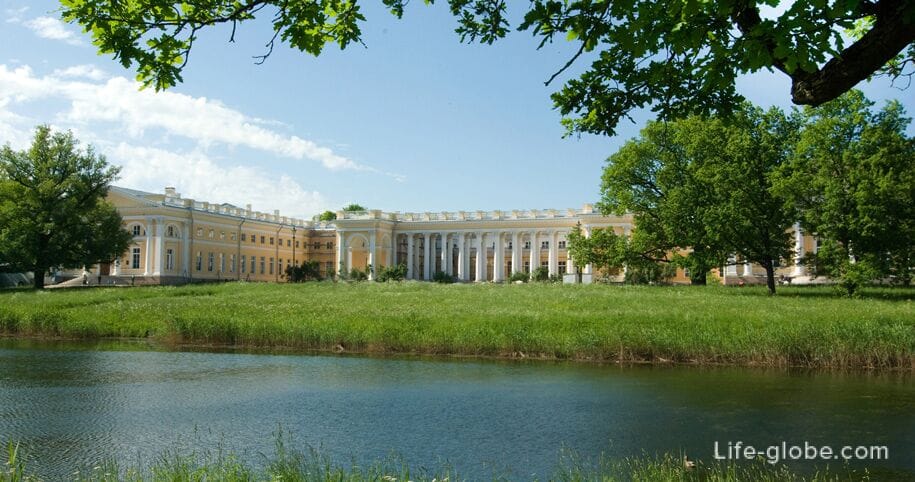

In the interior of the palace, in some rooms, the internal historical decoration has been partially preserved and the decoration has been fragmentally recreated.
The halls feature some of the apartment's interior items and personal belongings of the last Russian emperor and his family.
Within the walls of the palace there are: A corner living room, a hall with a slide, a Library, a State office of Nicholas II, a Moorish lavatory, a study, a Reception Room of Nicholas II, Bedrooms, a Lilac study of Alexandra Feodorovna, a Rosewood reception room of Alexandra Feodorovna, a Maple living room, etc.
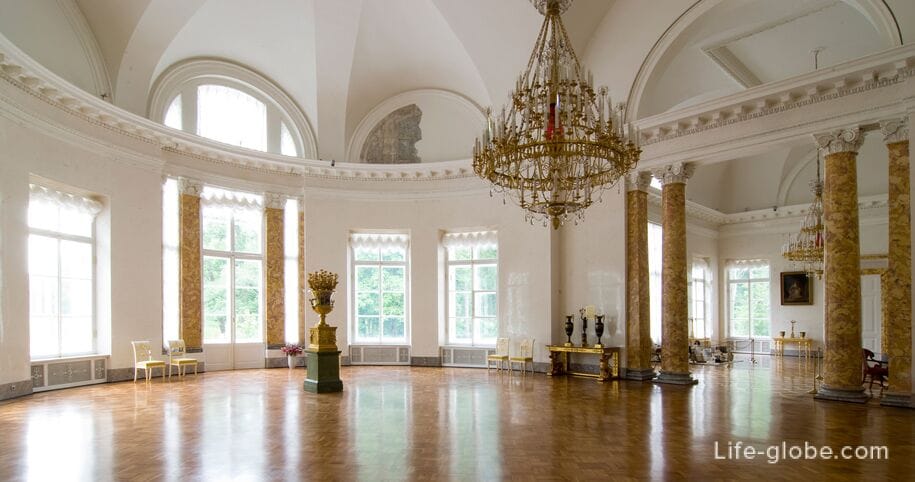
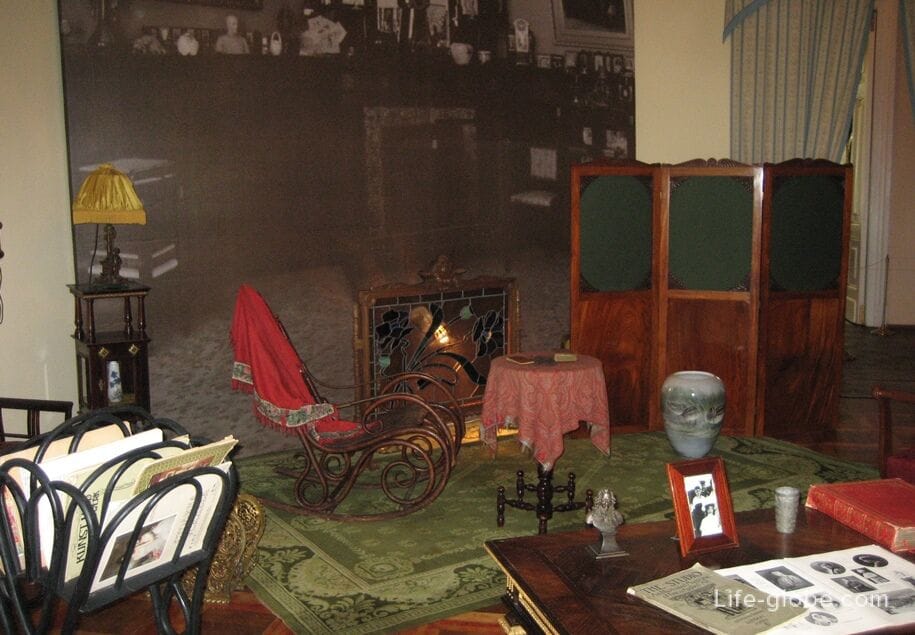

A separate building from the palace was erected a kitchen building, which is connected to the palace by an underground passage.
Regular part of the Alexander Park (New Garden)
The new garden was laid out in the 1740s by the architect N. Zhirov.
The new garden is a small part of the Alexander Park, which has a geometrically correct layout and is executed on the model of English landscape parks.
The new garden stretches behind the main entrance to the Alexander Park-opposite the Golden Gate of the Catherine Palace.
Behind the main entrance to the park there is a Large Chinese Bridge, from which the Linden Alley leads (the main, central alley of the Alexander Park). The alley is crossed by another alley - a wide clearing. The intersection of the alleys forms a cross dividing the New Garden into four equal parts (four stalls). On all four sides, the garden is surrounded by a Cross Canal, which was dug in 1748-1749 and which is crossed by bridges.
Photo of the Cross Channel

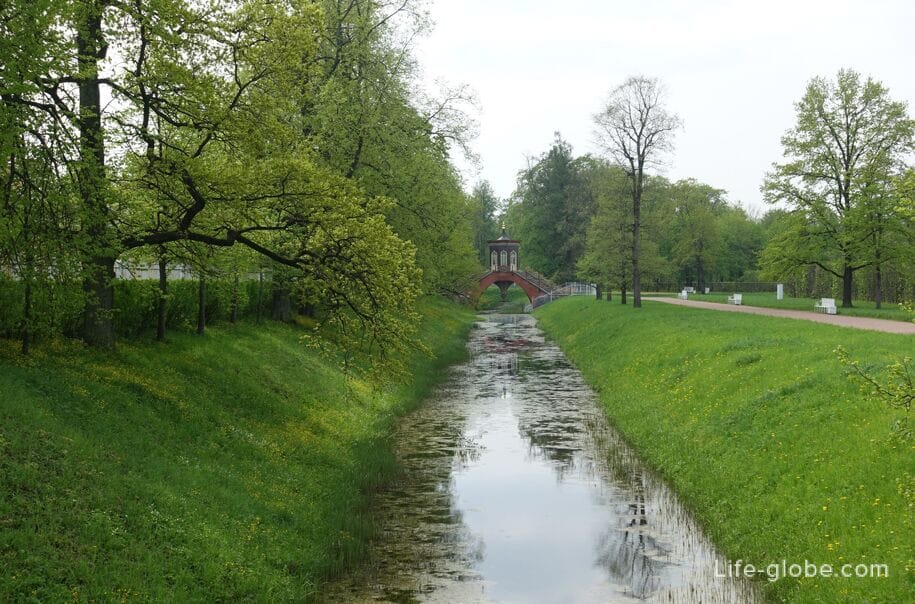
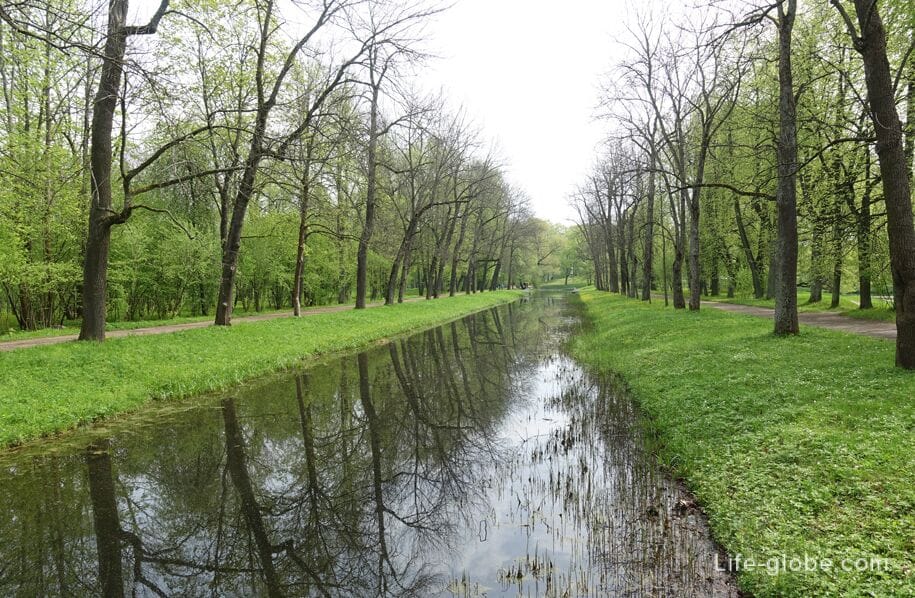

The Big Chinese Bridge is the most beautiful and popular of the bridges in the park. The bridge is decorated with granite vases and bright Chinese figures. Learn more about the Great Chinese Bridge…
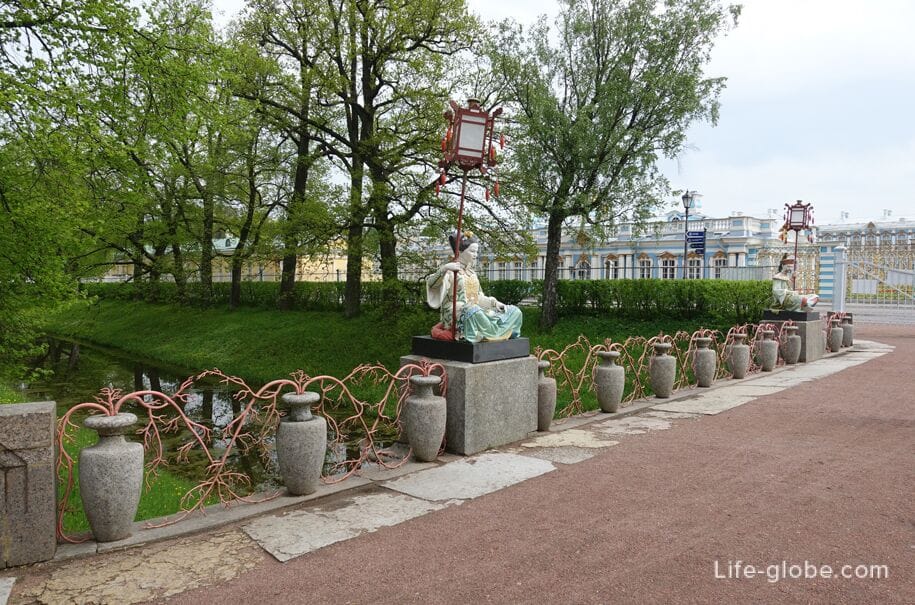
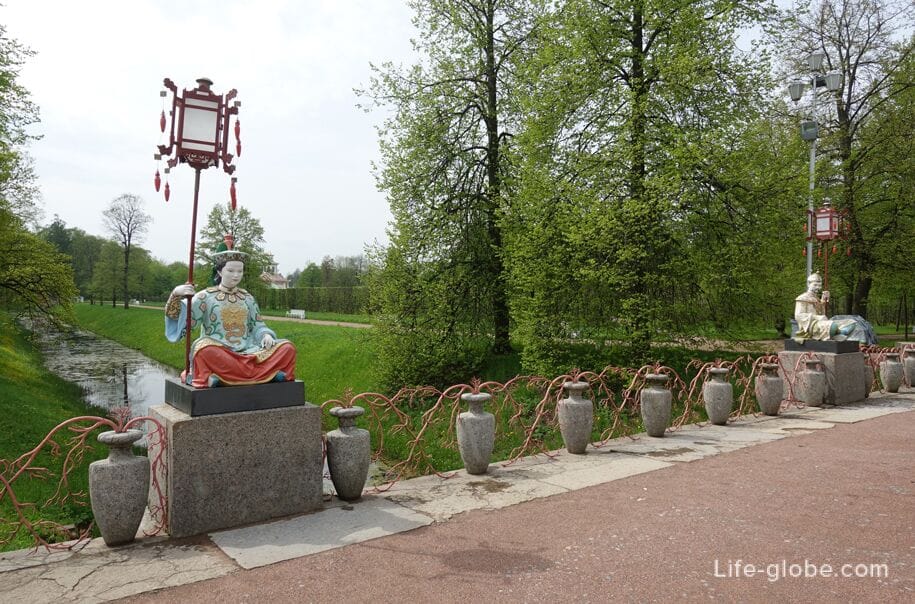
In the center of the stalls (between them) there is a flowerbed with a small obelisk "Glory to the heroes who fell in the struggle for the Great October".


The central alley of the park

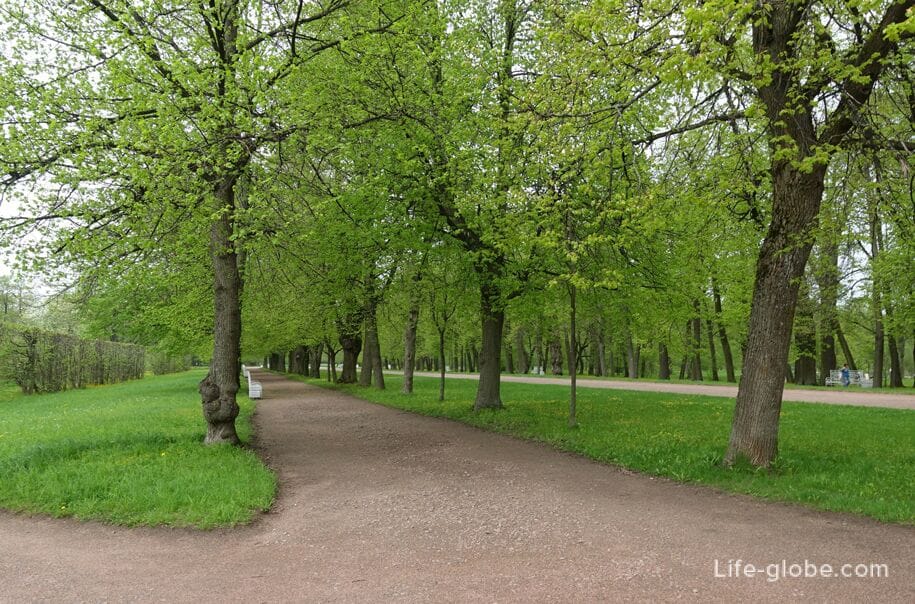
The alley leads toThe Dragon Bridge, on which four figures of winged dragons are installed.
The dragons' paws are stretched out, their tails bend in steep loops, and their torsos, resembling human ones, are proudly put forward. Learn more about the Dragon Bridge…
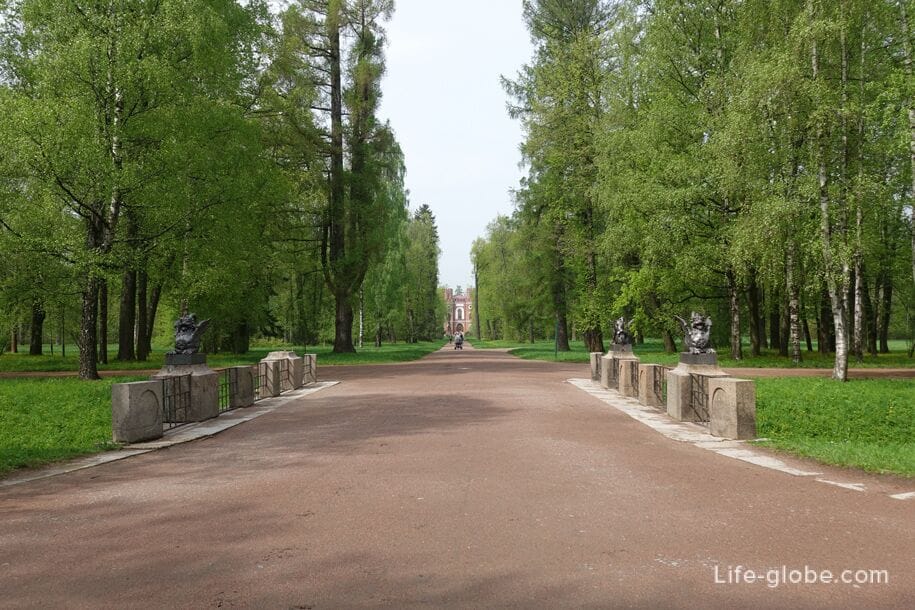
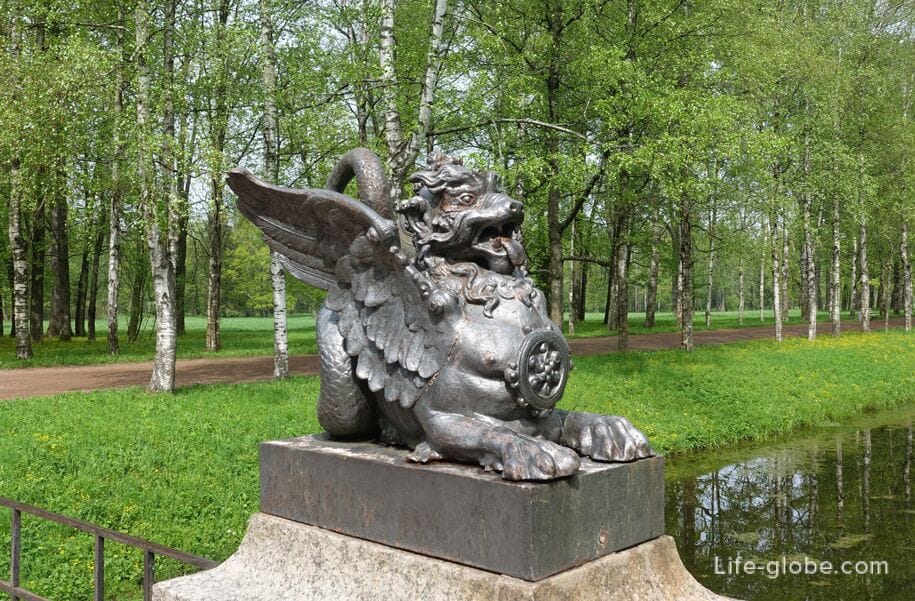
To the right of the Central Alley there are two stalls, in one of which there are ponds, lakes and bridges, including an elegant Shaky bridge.
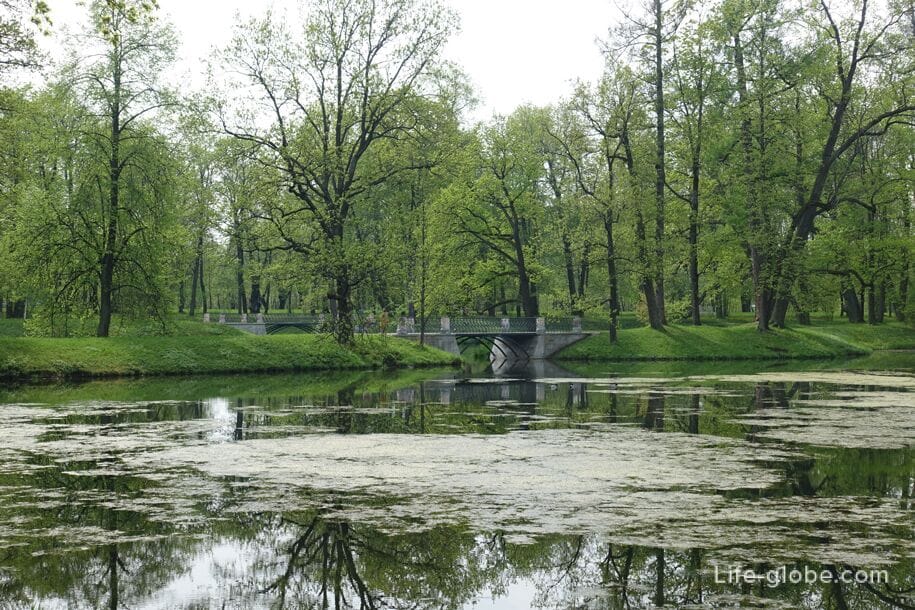
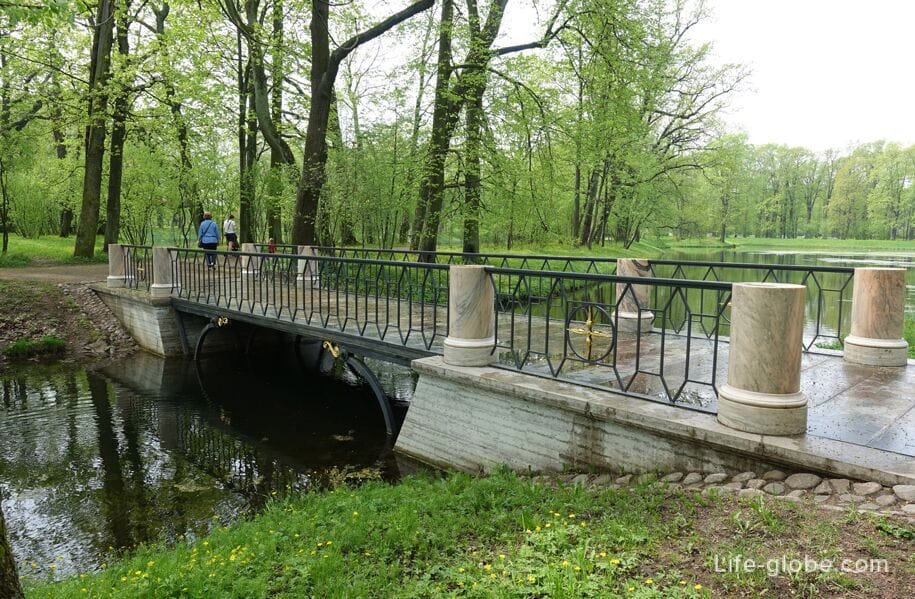
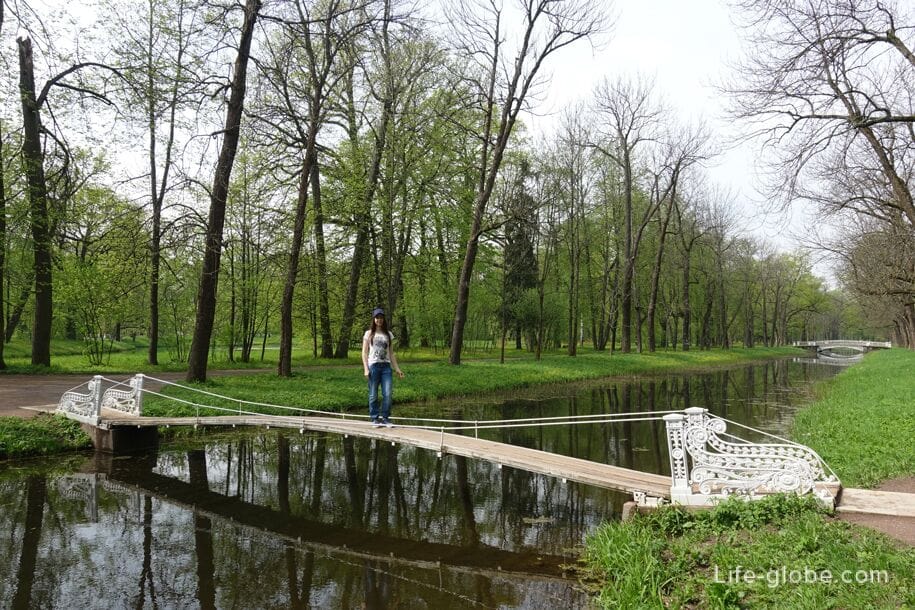


In the second stalls there is an embankment mountain "Parnassus".
The name of the mountain "Parnassus" is borrowed from Greek mythology: the god Apollo and the patron muses of the arts lived on Mount Parnassus. Similar conical mountains with a cut-off top and a gentle road descending along the slopes, lined with shrubs, were built in Renaissance parks and in regular gardens of the 18th century.
The Parnassus was erected in the Alexander Park in 1755. At the same time, trees were planted on the mountain.
A winding spiral path lined with trees leads to the top of the mountain.
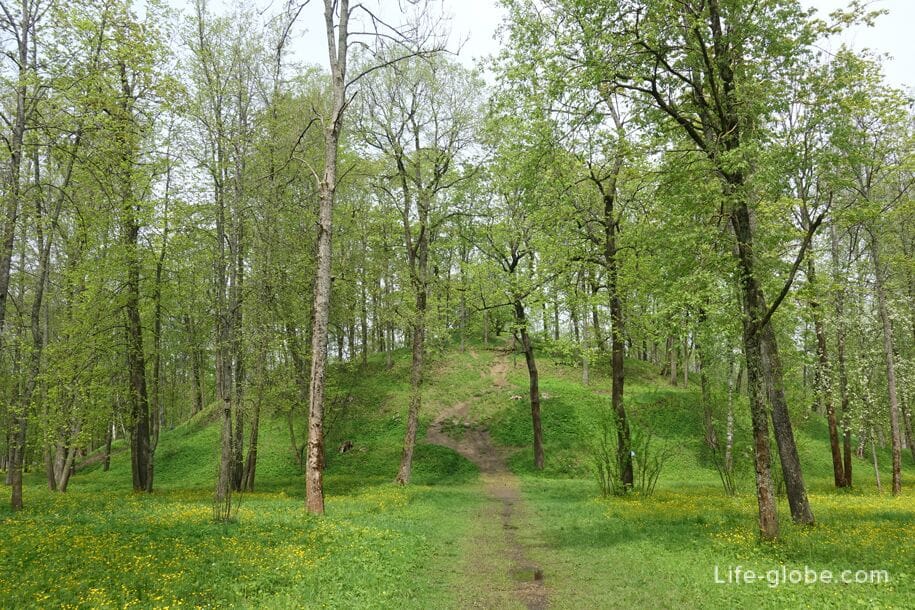
To the left of the Central Alley there are two more stalls, in one of which there is a curtain "Mushroom", in the center of which, on a small elevation, there is a round platform with benches, from which eight alleys radiate.
The name of the curtain "Mushroom" is associated with the shape of the gazebo, which was located in this place in the late 18th-early 19th centuries and is a bench with a tent in the form of a fungus, dismantled in the early 19th century.
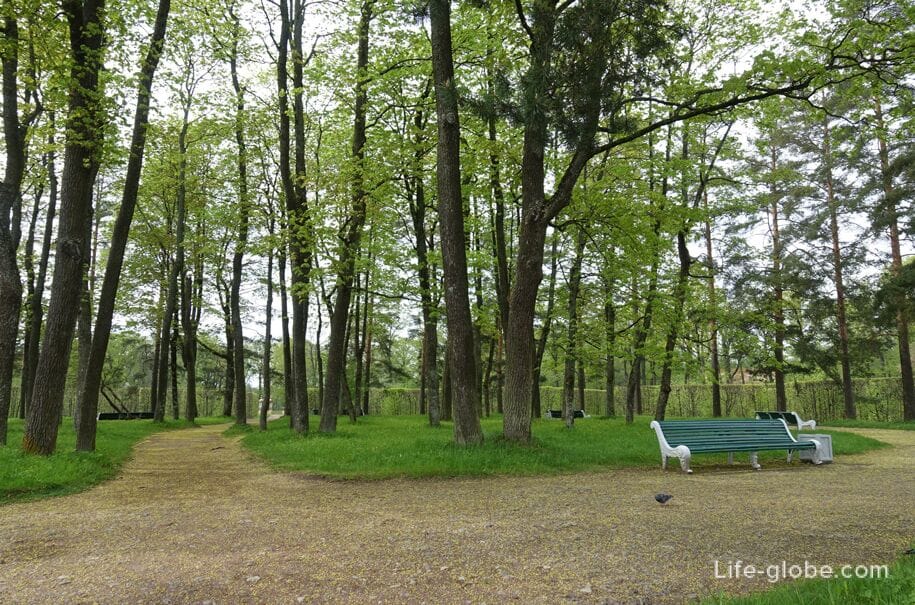
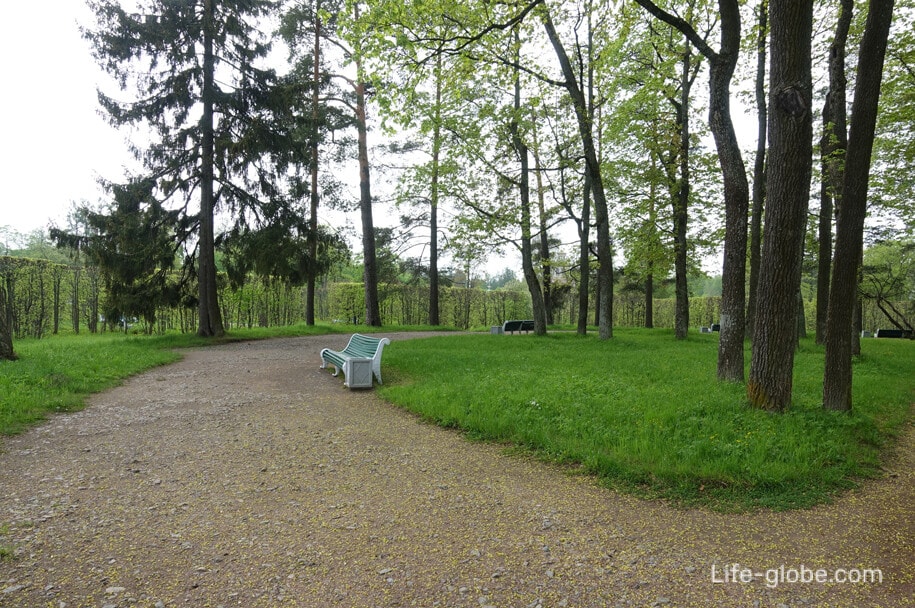
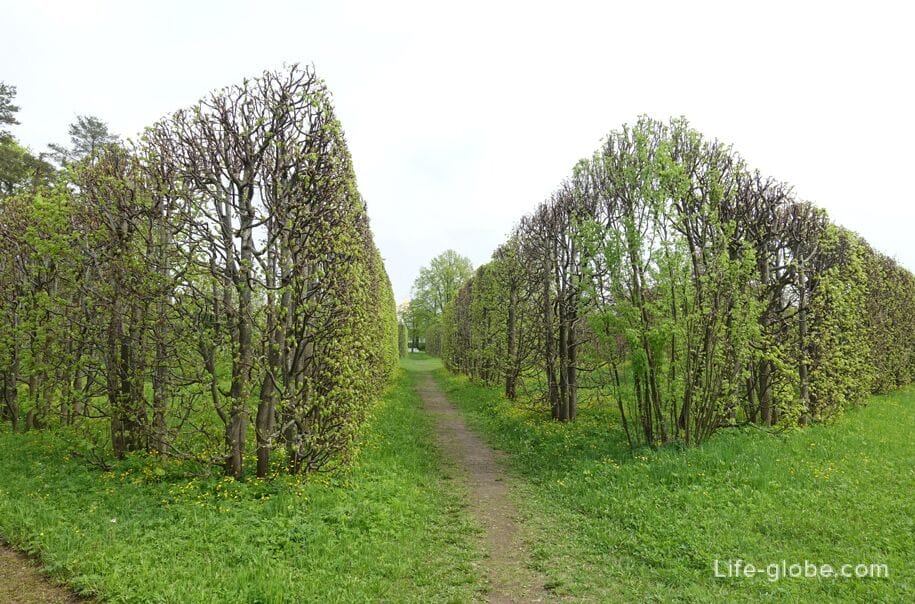
In the second stalls there isThe Chinese Theater, or the Stone Opera, as it was called during the reign of Empress Catherine II.
The construction of the theater was carried out from 1778 to 1779 according to the project of the architect A. Rinaldi and under the direction of I. V. Neelov.
The interior of the Chinese Theater was distinguished by splendor. The central box, the stage portal, the ceiling-everything was decorated with Chinese figures, dragons, shields with zodiac signs and other elements of oriental decor. There were performances staged in the theater.
After 1917, the Chinese Theater was used as a museum room.
On September 15, 1941, during the shelling of the city of Pushkin, the Chinese Theater completely burned out from the inside and was left without a roof.
The theater is planned to be restored and adapted for modern use.

A Soviet military figure, Lieutenant General Ivan Vasilyevich Khazov, who was killed in battle on April 13, 1944 during offensive military operations in the direction of Pskov, is buried near the Chinese Theater.
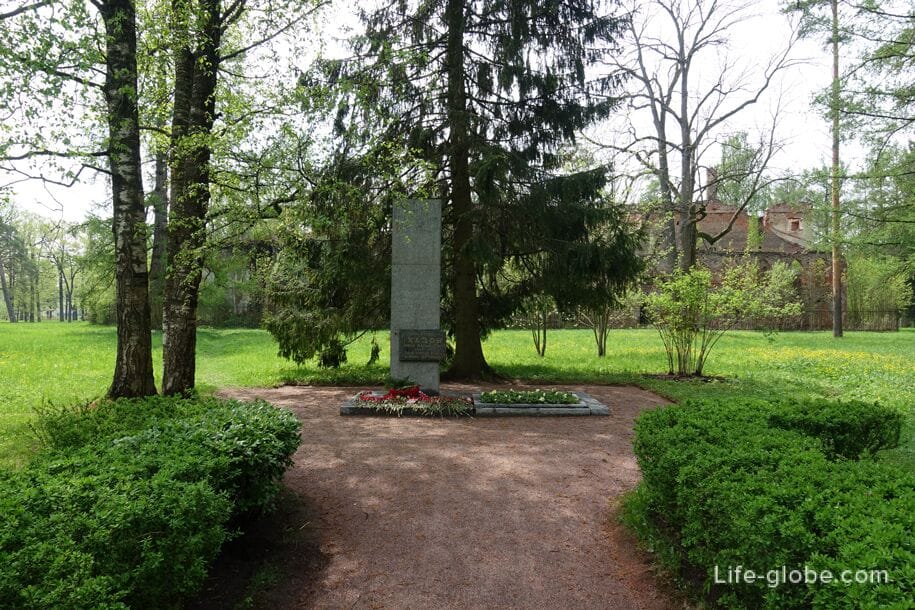
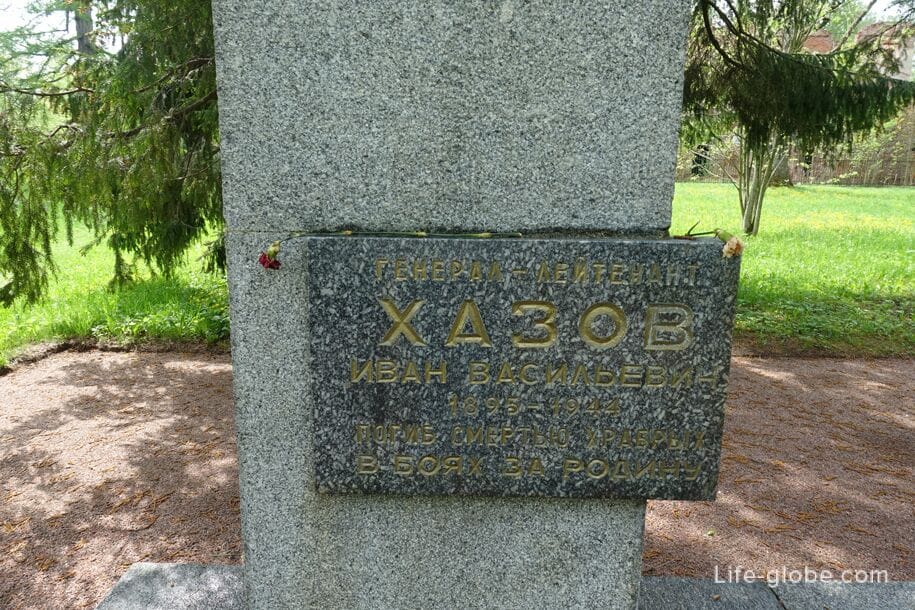
Behind the stalls, a monumental bridge is thrown across the Cross Canal Cross Bridge and two Small Chinese bridges.
The architecture of the bridges reflects the fascination with China, characteristic of Russia at the turn of the 18th and 19th centuries.
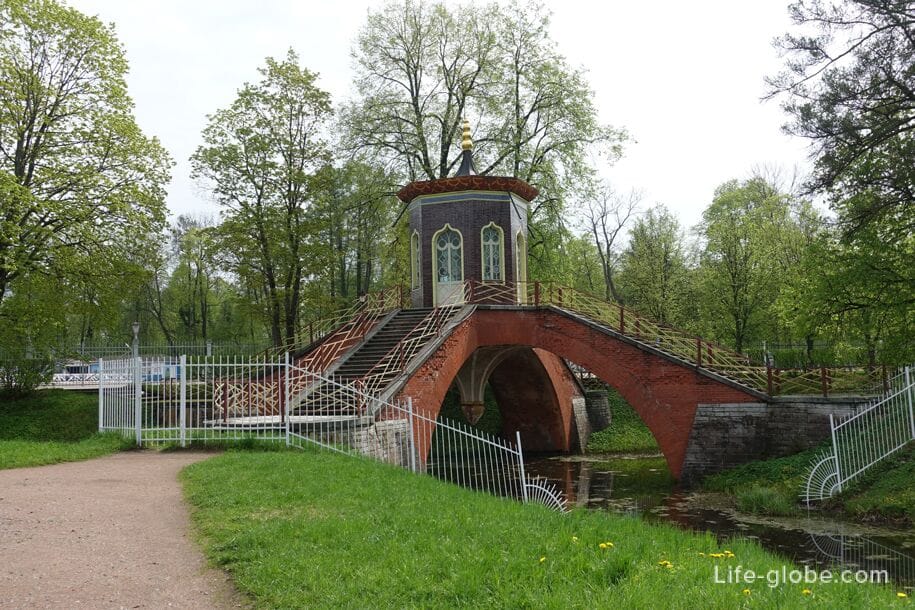

The New Garden of the Alexander Park also includes:
- The Chinese village, the construction of which was started in the mid-1780s by the architect Ch. Cameron.
At that time, 10 one-story houses and an unfinished Chinese-style observatory building were erected.
In 1817-1822, after repair work, the houses were turned into apartments: V.P. Stasov connected them in pairs and redeveloped them inside, adapting them for housing. The unfinished observatory pavilion was completed with a spherical dome, which was preserved until 1941.
In the 19th century, the Chinese Village was used as a guest apartment.
Currently, the Chinese village has been completely restored, and its houses are again used as guest and residential apartments;
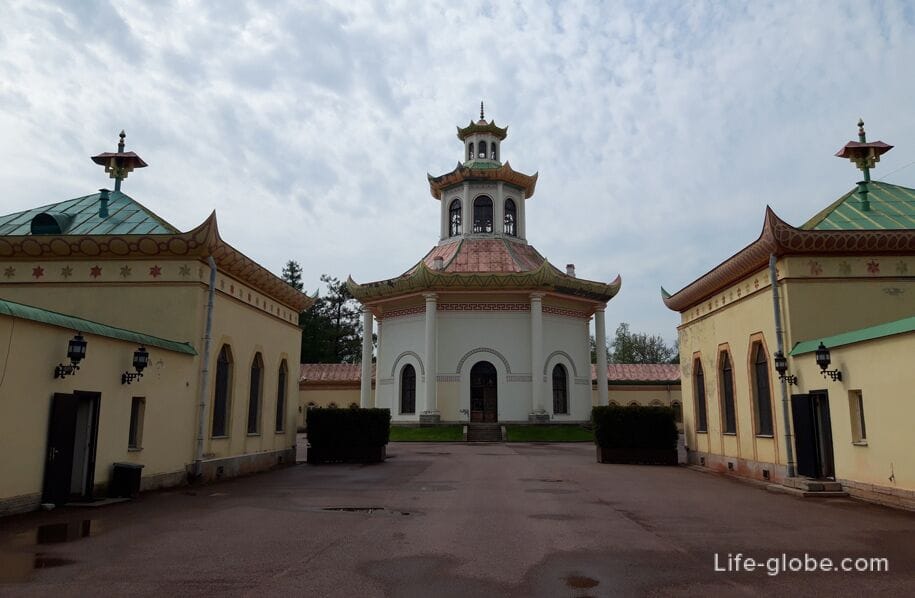
- A big whim andA small whim.
The Catherine and Alexander parks are separated by a Podkaprizaya Road, which got its name due to two structures-the Big and Small Whims.
Both caprices are artificially formed embankments with arched spans over the road.
The architectural design of the Bolshoy and Maly Caprices belonged to V. I. Neelov, who, together with the engineer and architect I. Gerard, built them in 1770-1774.
The big caprice has a grandiose arch with a width of more than five and a height of more than seven meters. Next to the big arch there is a second - a small arch, built in an earthen embankment. At the top of the Big Whim there is a Chinese gazebo: eight columns of pink marble support the spectacularly curved" Chinese " roof.
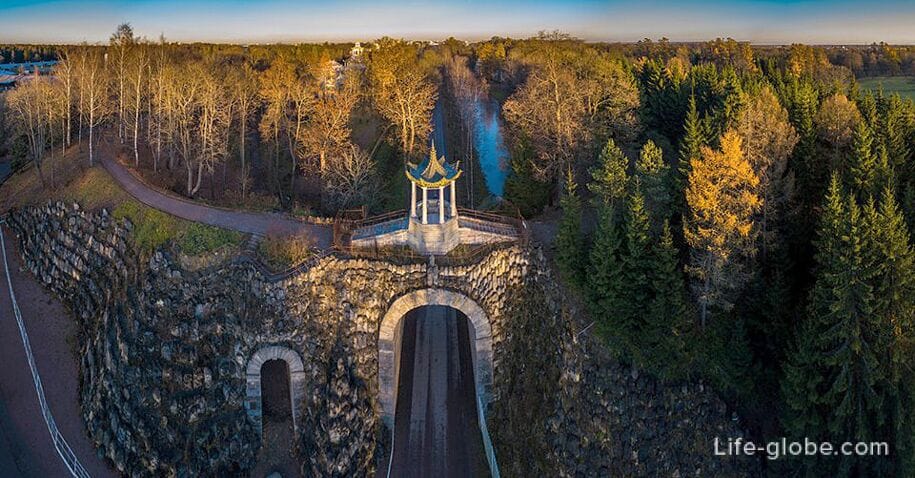
A small caprice, in comparison with a Large One, looks very modest and is a simple arch without exquisite decorations.
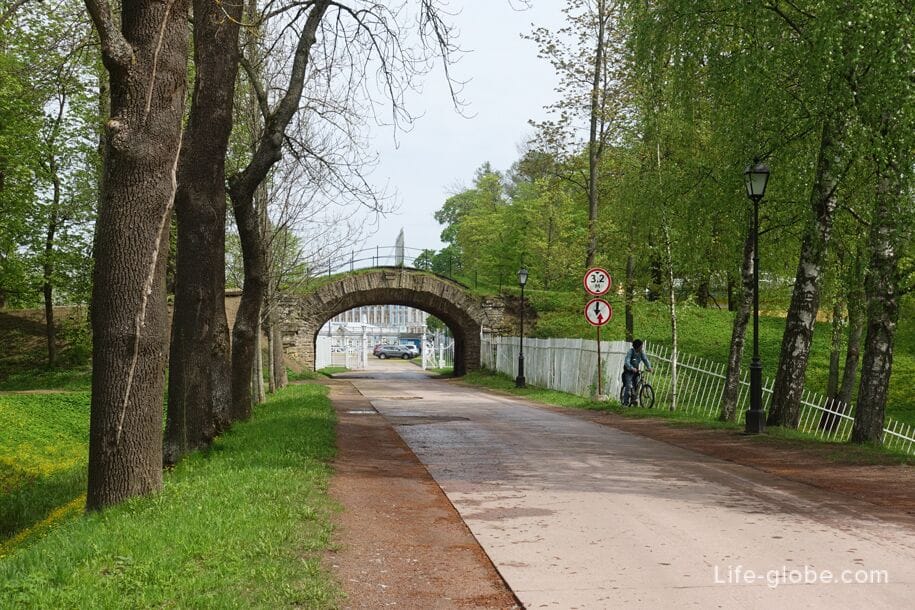
Alexandrovsky Park Landscape Park
The New Garden and the Landscape part of the Alexander Park are not visually separated from each other and together represent a single park ensemble.
The landscape park occupies a large part of the Alexander Park, where previously there was a menagerie and grounds for the imperial hunt. In the future, a complex of buildings - pavilions was erected in the park.
The landscape park has dense natural vegetation, ponds (Kitchen, Children's, Facade and Lamsky), alleys for walking and places for recreation, as well as pavilions, an old horse cemetery and a grotto-spring.
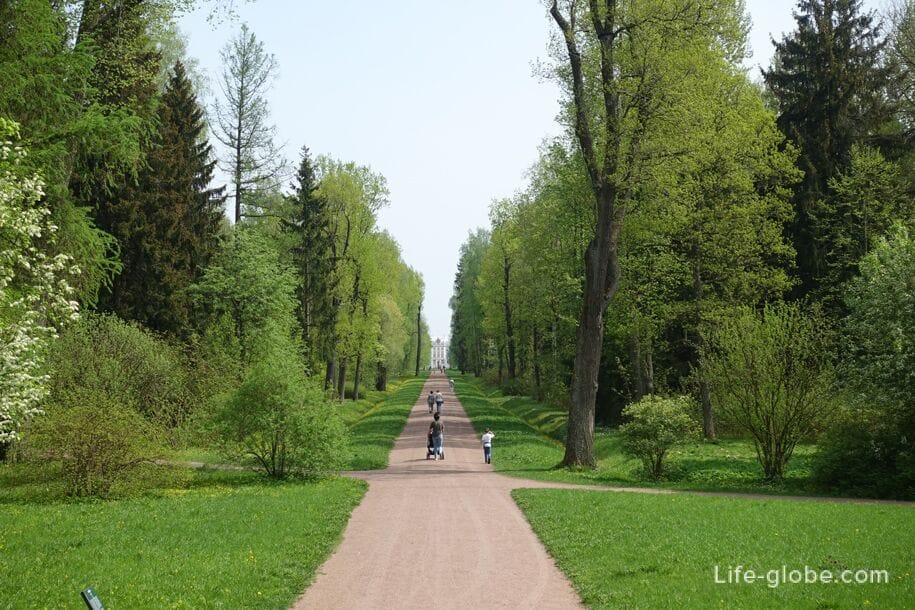


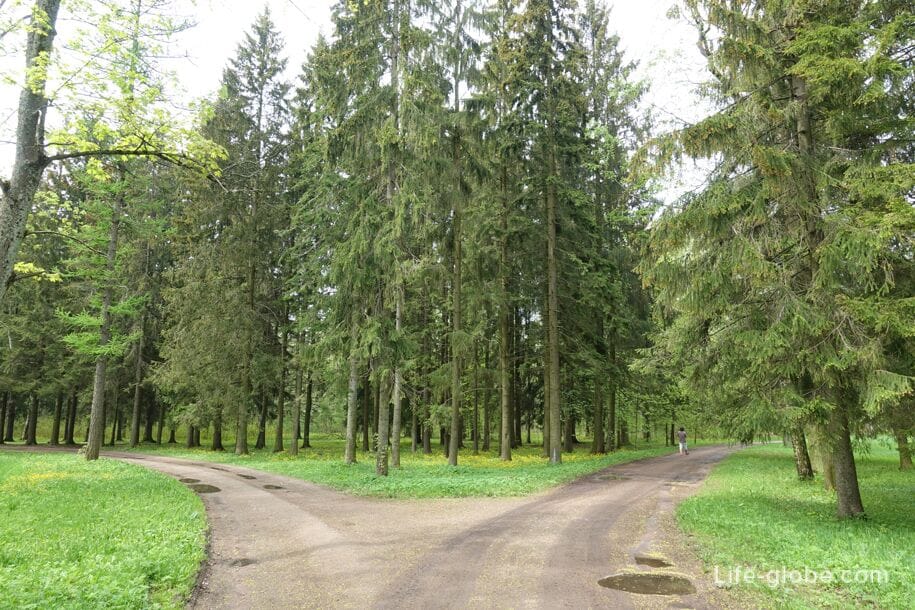
In the Landscape Park
The children's house, located on an island among the Children's Pond and not far from the Alexander Palace, is a small pavilion designed by architect A.M. Gornostaev in 1830 for the children of Emperor Nicholas I. The house consisted of a living room and four small rooms, decorated quite simply. Before the Great Patriotic War, children's furniture was preserved in them, covered in the rooms of Grand Duke Alexander Nikolaevich (the future Emperor Alexander II) leather, and in the rooms of his sisters Maria, Olga and Alexandra - cretonne.
In the 19th century, it was possible to sail to the island by a small ferry, and at the end of the century - by boat, through the lock, built in 1898.
In the second half of the 19th century, several favorite imperial dogs were buried on the island. The burial places were marked with small tombstones, two of which have survived to this day.

The Chapelle Pavilion (which means "chapel" in French), which looks pretty "shabby", but this is not for nothing, this is how it appeared in the park in the 19th century - in the form of a Gothic chapel (chapel) destroyed by time. More about the Chapelle Pavilion…
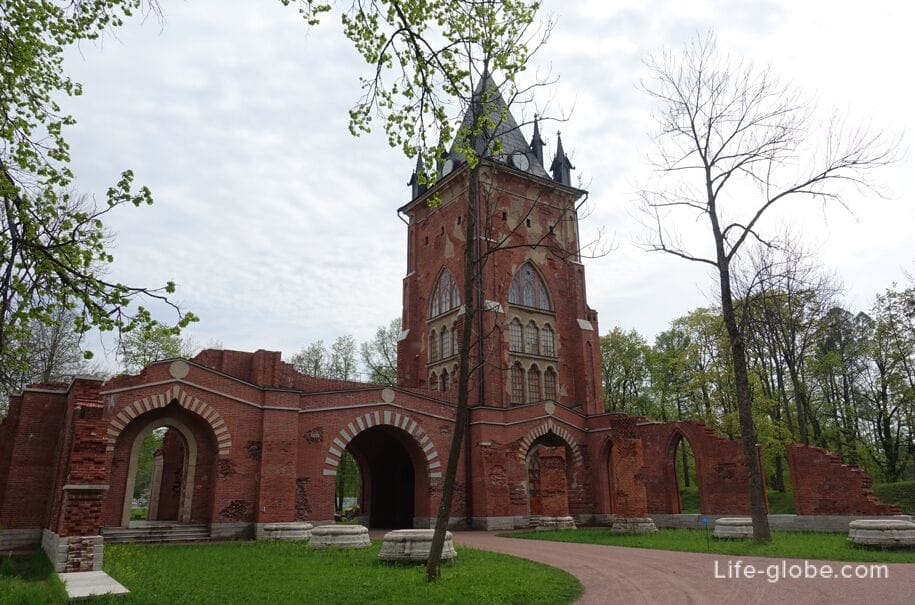
The Arsenal Pavilion, which is the main pavilion of the Landscape Park.
The Arsenal Pavilion was built under the emperors Alexander I and Nicholas I in 1819-1834 on the site of the dilapidated Montblijou pavilion, built in 1747-1754, used as a hunting pavilion and housed in the so - called Menagerie-on the territory where animals were kept in natural conditions and which was used as hunting grounds.
Upon completion of the construction, the Arsenal became one of the monuments of Russian Neo-Gothic architecture of the 19th century.
Today, the pavilion houses the exposition "Tsarskoye Selo Arsenal. The Imperial Collection of Weapons". Admission is paid; tickets can be purchased at the ticket office of the pavilion itself or online in advance-on the website of the Tsarskoye Selo Museum-Reserve (the site is indicated at the end of this article). Learn more about the Arsenal Pavilion and the Museum...


Next to the Arsenal pavilion there is a grotto-spring, decorated in the style of medieval Gothic architecture.
It is a small granite canopy over a spring that gives rise to a stream that flows into the Lamsky pond of the park.
The grotto has the shape of a hemisphere, is made of raw stone, and the facade is lined with granite slabs, creating an arched opening. Steps lead to the spring, there is a bench next to it.
Once the water in the spring was considered extremely clean, but now the administration of the State Museum-Reserve "Tsarskoye Selo" does not recommend using water from the source.
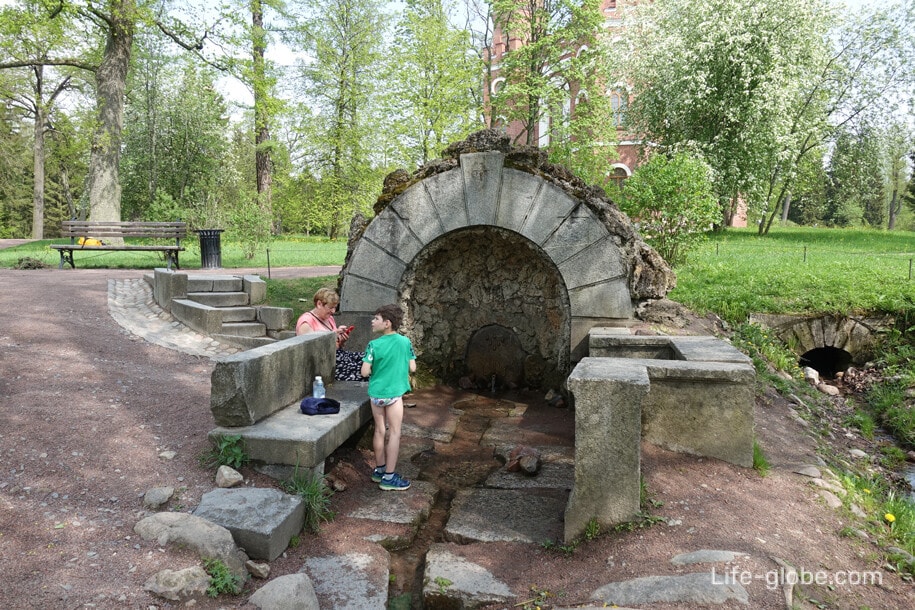
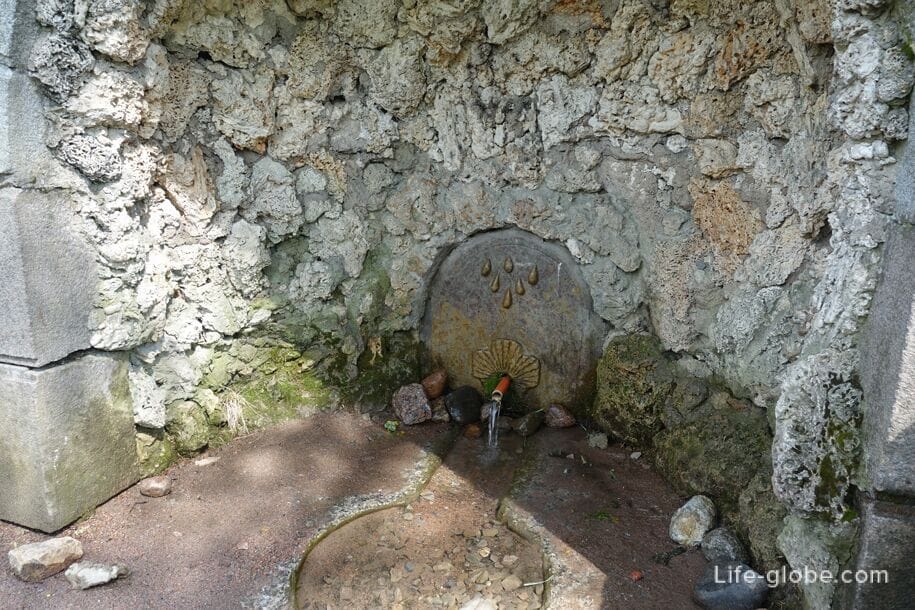
At the Lamsky Pond, not far from the Arsenal Pavilion and the grotto-spring, there are the ruins of the Lamsky pavilion, destroyed during the Great Patriotic War.
The pavilion was built in 1820-1822 by A. A. Menelas specifically for the maintenance of lamas sent as a gift to Emperor Alexander I from South America.
During the reign of Emperor Nicholas II, fallow deer were kept in the manege, brought in 1907 from Southern Mongolia. At the beginning of the 20th century, apartments for park guards were arranged in the premises for service personnel.
The White Tower, which is a complex resembling a medieval knight's castle, which now includes: the ruins of the gate, the White Tower itself, surrounded by a small garden, as well as a moat and rampart.
The White Tower complex was built in 1821-1827 according to the project of the Scottish architect Adam Menelas for the children of Emperor Nicholas I - Grand Dukes Alexander, Nicholas, Michael and Konstantin, who were engaged in military and gymnastic exercises in the complex.
Currently, the pavilion houses the interactive center of the Tsarskoye Selo Museum-Reserve, where various classes, interactive programs, holidays and master classes for children are held.
The entrance to the territory of the complex "White Tower" is free (free). Learn more about the White Tower Complex…

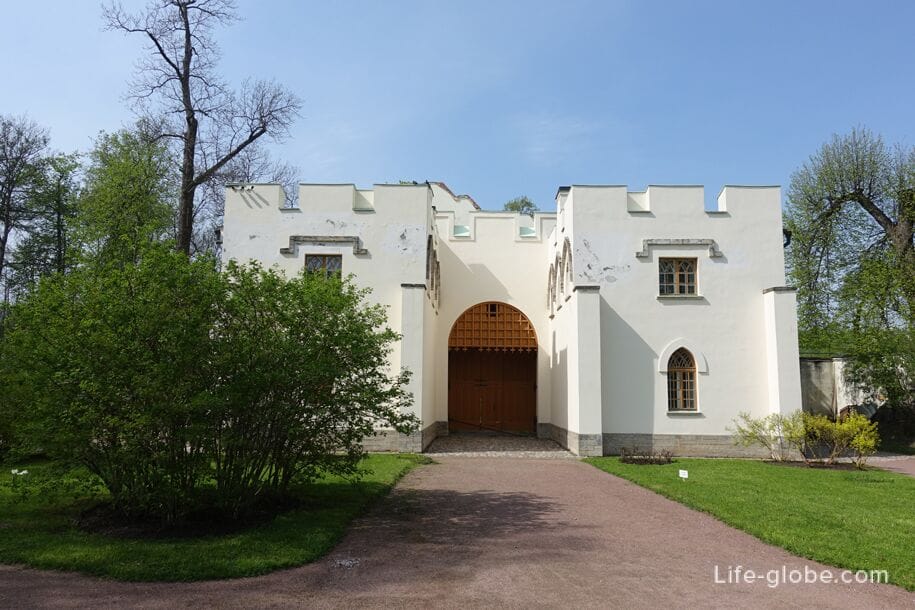
Not far from the northern border of the Alexander Park, on the territory of the former menagerie, there is a buildingA retirement stable.
In January 1826, Emperor Nicholas I ordered the transfer of eight riding horses of "Emperor Alexander Pavlovich's Own saddle", who lived out their life "on pension" in the stables of St. Petersburg, to Tsarskoye Selo, where they were to be given a room.
The building, called the "Pensioner's Stable", was built in 1827-1829 by the architect A. A. Menelas.
Part of the clover meadow to the west of the stable building was turned into a pasture for horses.
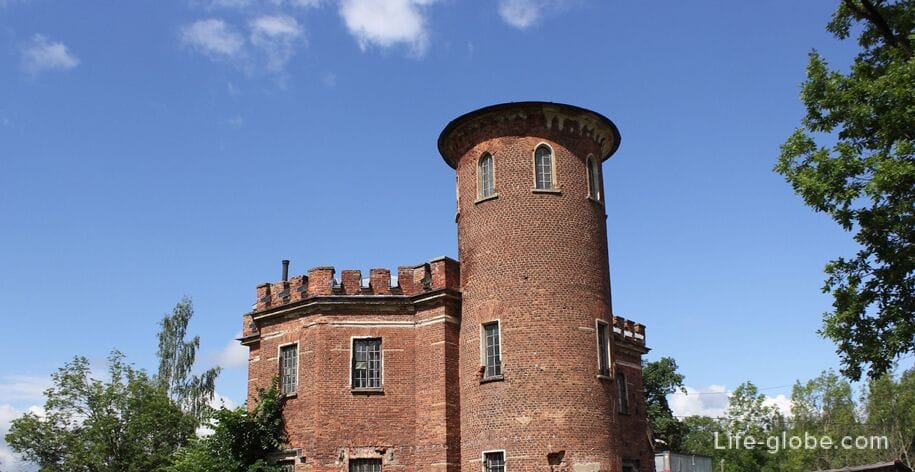
Not far from the southern facade of the Pensioner Stable building there is a cemetery of horses, where the horses of "The Emperor's Own Saddle" found their last refuge.
Rows of stone slabs with inscriptions carved on them indicate the burial places of the favorite horses of Russian emperors: from Alexander I to Nicholas II.
The first burials in the cemetery of horses appeared in the 1830s, and the last were made shortly before the revolution of 1917.
In total, there are more than 110 graves in the cemetery. Here lie Lamy, the horse of Emperor Alexander I; Flora, who wore Emperor Nicholas I; the horse Cob, on which Emperor Alexander III rode the troops, and others.
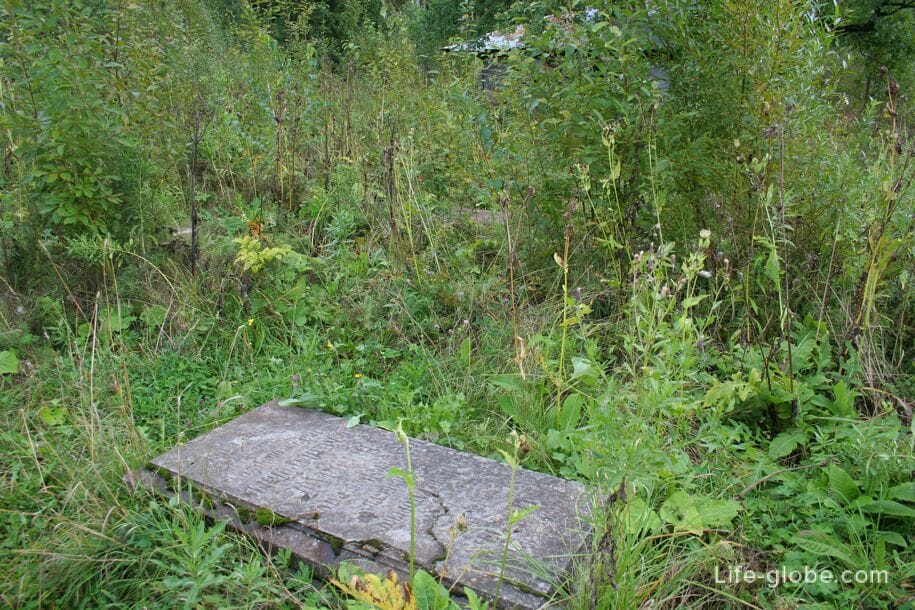
Krasnoselsky Gate or Elephant Gate, also known as White Guards and Stone Guards, located on the northwestern outskirts of Alksandrovsky Park, near Babolovsky Park.
The gate was built in 1823-1824 in the Neo-Gothic style by the architect A. Menelas.
The name "Elephant" gate was given because of the "Pavilion for Elephants" located nearby in the park, built in 1828.
The gate consists of two symmetrically arranged brick guardhouses, faced with Pudost limestone and topped with battlements of the same material. The buildings are decorated with lancet windows in the bay windows. Between the guardhouses there are cast-iron gate grilles.
In 1846, the metal part of the gate was moved to the Staro-Krasnoselskaya Road, at the place where it left Babolovsky Park. In the new place, the gates received a new name - Staro-Krasnoselsky, and the guardhouses deprived of a metal part were called White or Brick guardhouses. Hence all the names of the gates.
In the period from December 2005 to May 2008, during the restoration, the cast-iron gates were returned to their former place and the appearance of the pavilions was restored.
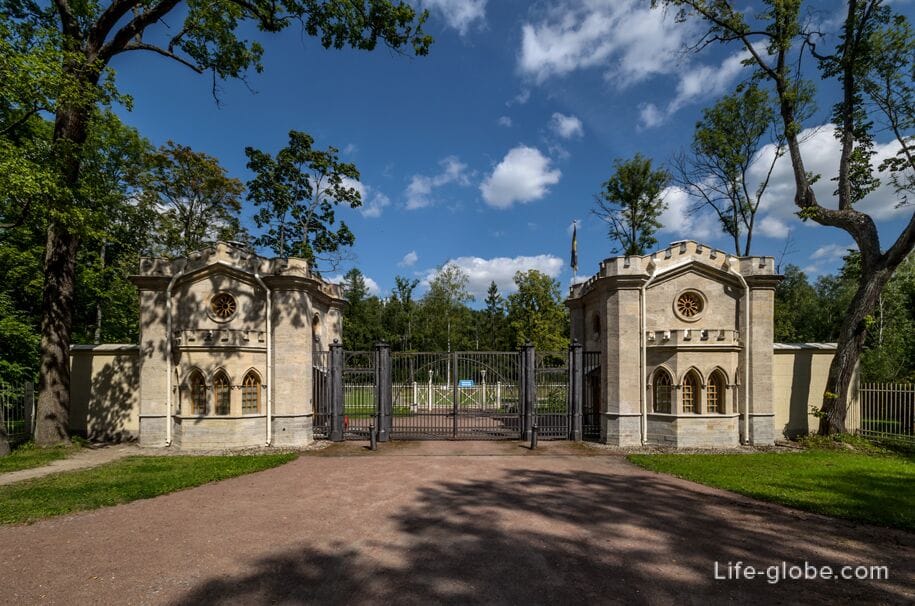
In the northern part of the Alexander Park (now outside the park, across the Farm road) there areAn imperial farm and a vast plot of land that was once intended for grazing cattle.
The farm complex was built by A. A. Menelas in 1818-1828 and consisted of a pavilion of the highest presence, a dairy, a cowshed, sheds for merinos, a caretaker's house and other buildings on the meadows of the park adjacent to the complex of the Imperial Farm, where cattle were grazed.
In numerous outbuildings on the territory of the farm there were services and apartments of a veterinarian and stockmen. In one of the pavilions of the Dairy there was a large glacier and a creamery. The other pavilion, consisting of two living rooms, a dining room, a kitchen and four sofa rooms upstairs, was preserved at the beginning of the 20th century in the form that the architect A. A. Menelas created it (in case of visiting the farm by the highest persons).
At present, the best preserved buildings of the Imperial Farm are the Cowshed building and the Caretaker's House, built of red brick.
Now the Equestrian Complex of the museum-reserve is located on part of the territory of the former Imperial Farm.
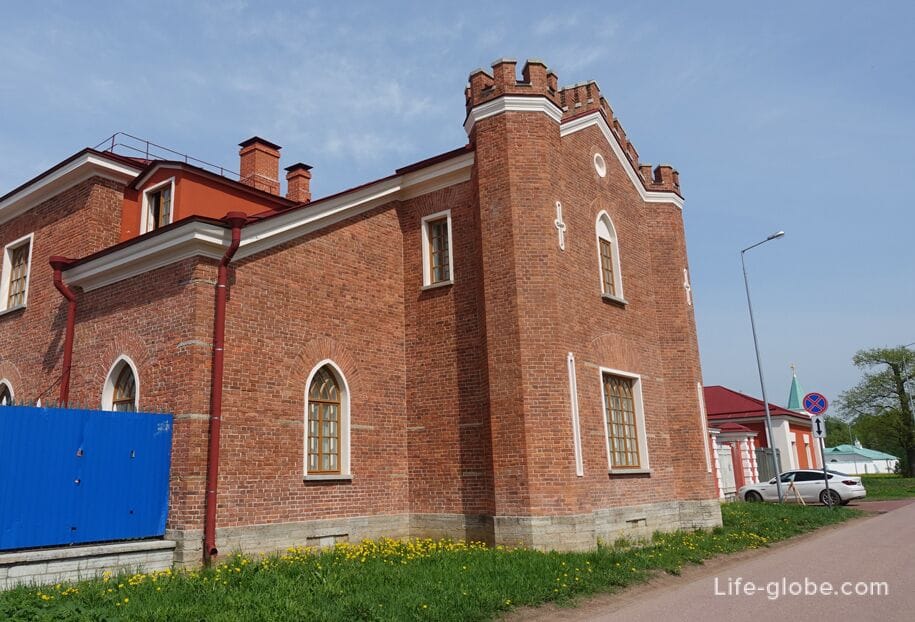

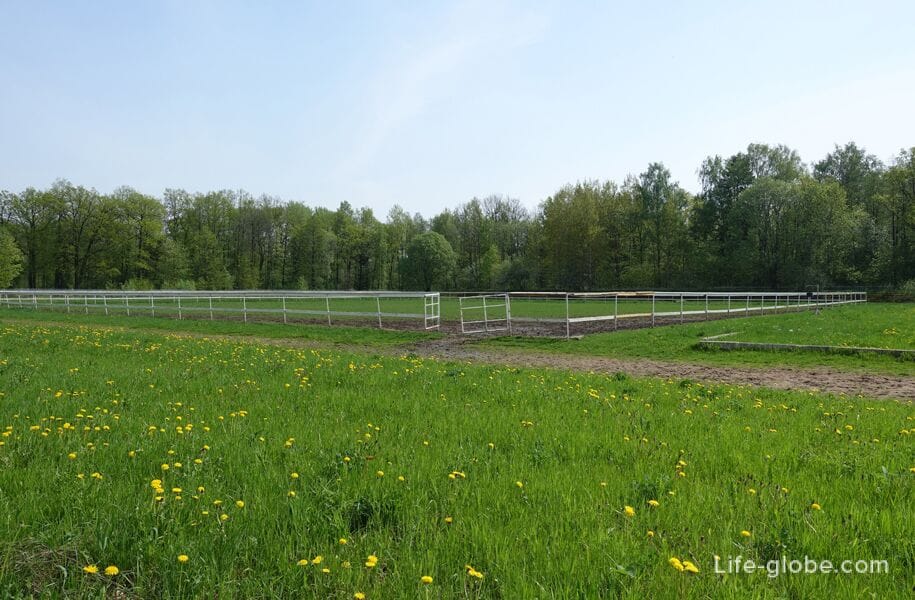
Next to the complex "Imperial farm", also outside the park, there isThe military chamber, which is a monument of architecture of the neo-Russian style and consists of a complex of buildings, in the center of which there is a courtyard.
The military history museum "Russia in the Great War", dedicated to the participation of the Russian Empire in the First World War, is located within the walls of the military chamber.
Admission is paid; tickets can be purchased at the ticket office of the Military Chamber or online in advance-on the website of the museum-reserve. Read more about the Military Chamber and the Museum with photos…
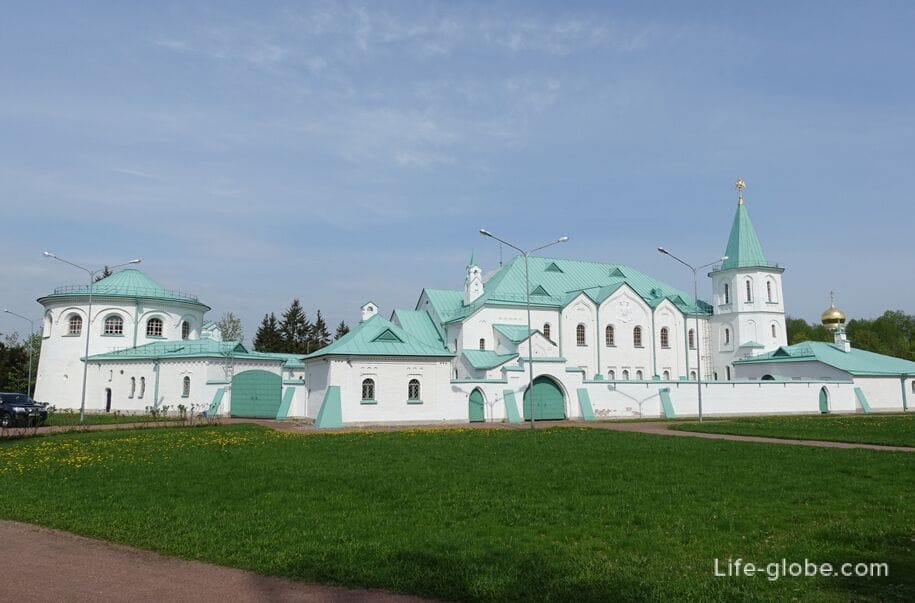
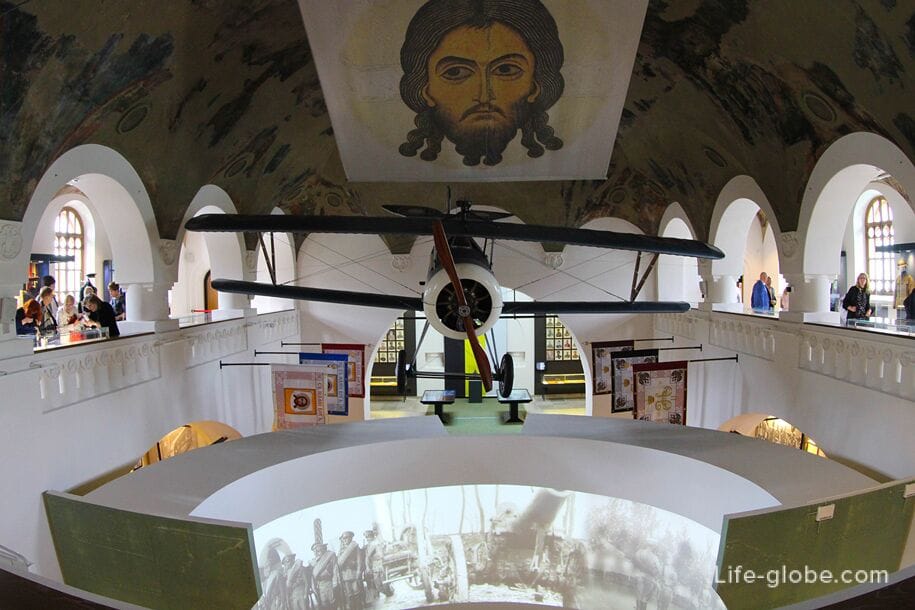
Map-scheme of the Alexander Park (park plan)
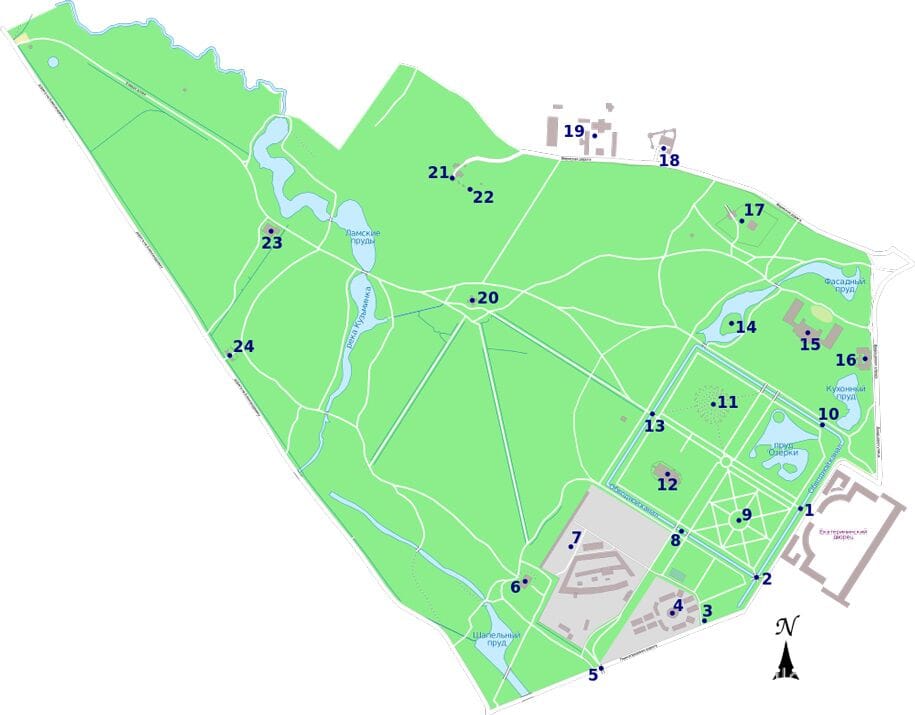
Practical information
The Alexander Park and the Alexander Palace represent a single palace and park ensemble and are located in the city of Pushkin (formerly Tsarskoye Selo) of St. Petersburg.
Coordinates of the Alexander Park: 59°43'18.0"N 30°22'38.0"E (59.721667, 30.377222).
Coordinates of the Alexander Palace: 59°43'15.0"N 30°23'33.0"E (59.720833, 30.392500).
The Alexander Park with pavilions, together with the Alexander Palace, belong to To the State Museum-Reserve "Tsarskoye Selo".
The entrance to the park is free (free of charge).
You can visit an excursion in the Alexander Park for a fee, as well as take a ride with an electric car tour. There was a bicycle route through the park.
Entrance to the museums-pavilions of the park and to the Alexander Palace is paid.
Tickets to the palace and the museums-pavilions of the park can be purchased at the ticket offices, or in advance-online on the official website.
We recommend that you check the working hours of the park, park pavilions and the palace, as well as the conditions of visiting, the cost of tickets, excursions and reconstruction on the territory of the park on the websiteThe State Museum-Reserve "Tsarskoe Selo": tzar.ru.
You can visit Tsarskoye Selo (the city of Pushkin) with one of the excursions
You can find out about all the ways to get to Pushkin from St. Petersburg (the airport and the city center) here →
In Pushkin, near the Alexander Park and the Palace, you can stay
The 5-star Pevcheskaya Tower Hotel offers restaurants, a bar, a rooftop observation deck, free Wi-Fi and parking.
Breakfast is included in the room rate. Link to the hotel

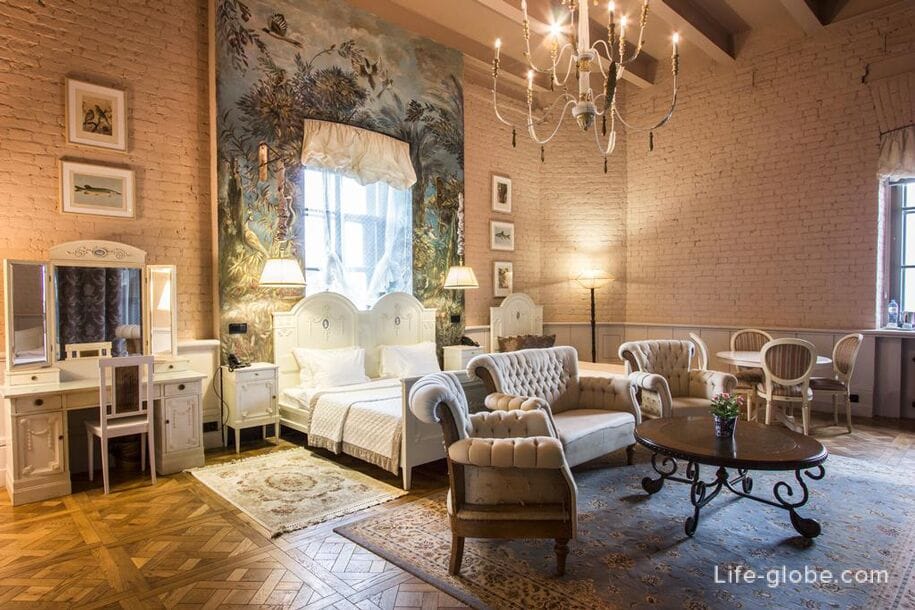
The 5-star luxury spa hotel "Tsar Palace Luxury Hotel & SPA"is located in a historic building.
The hotelhas a spa center with a swimming pool, a hammam, a salt sauna, a snow fountain, steam baths and a gym; free Wi-Fi, a 24-hour front desk, 2 restaurants, a lobby bar, private parking and meeting and conference rooms.
The rooms are equipped with climate control, a mini-bar, a safe and a private bathroom.
A buffet breakfast is included in the room rate. Link to the hotel
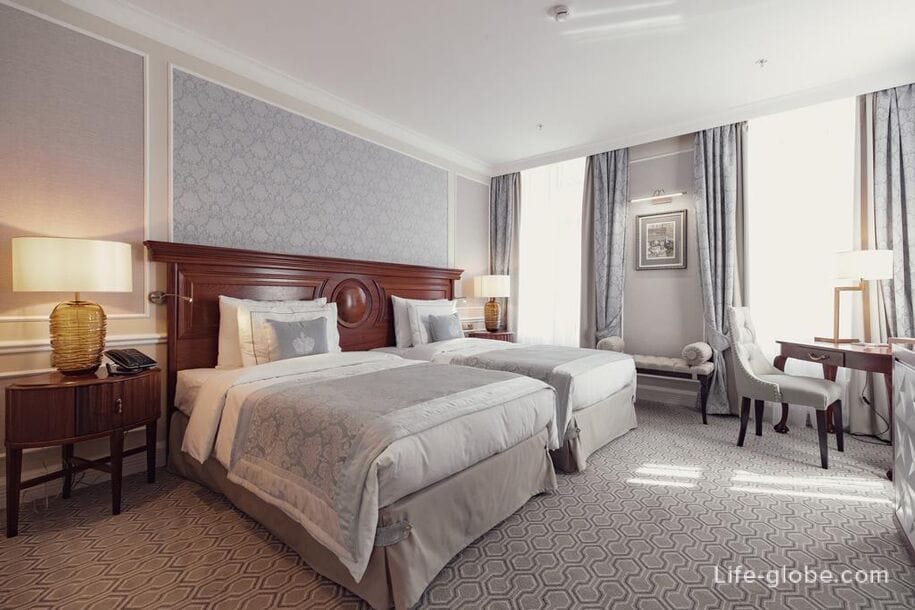
3-star hotel Ekaterina, located on the territory of the Catherine Palace and Park Ensemble.
At the hotel: 24-hour front desk, cafe, free Wi-Fi and parking.
The rooms are equipped with: air conditioning, TV, work desk and free toiletries.
Breakfast is included in the room rate. Link to the hotel
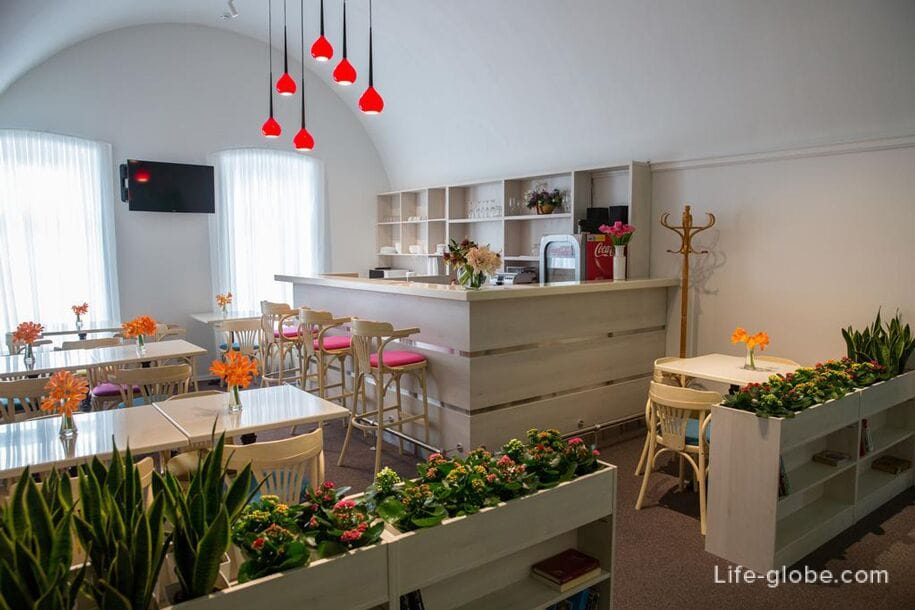
All accommodation facilities in St. Petersburg, including in the city center and in Pushkin, can be viewed and booked here






